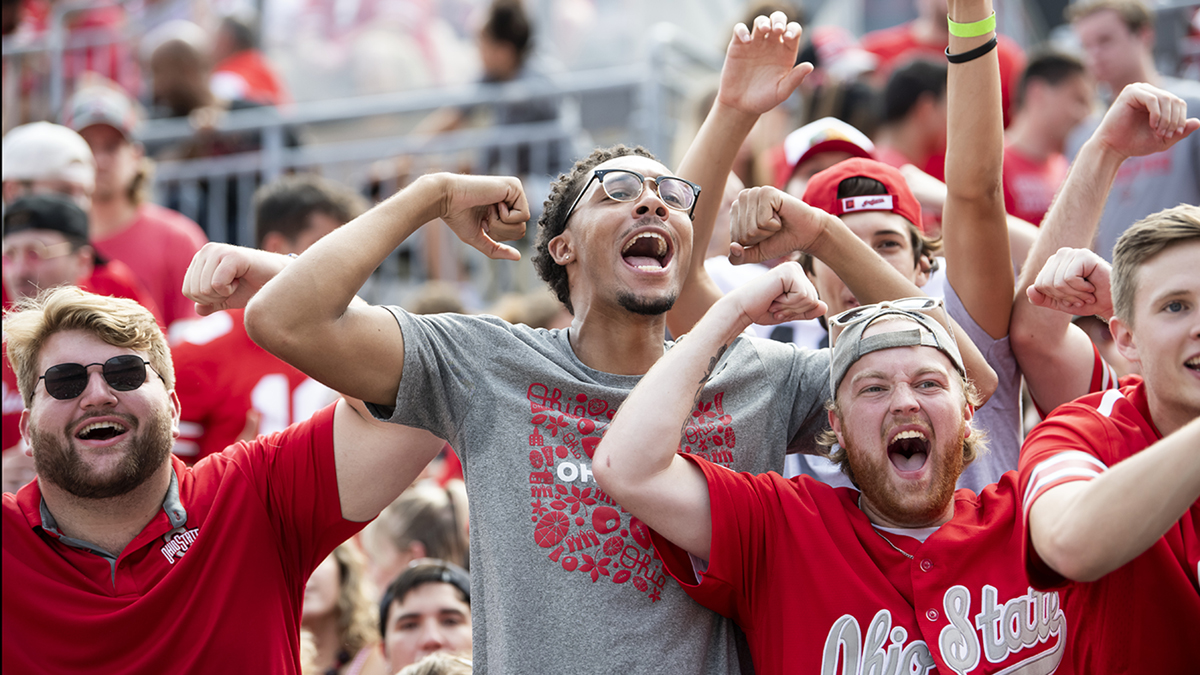Ohio Stadium ‘FanQuakes’ make seismic impressions
Ohio Stadium ‘FanQuakes’ project helps engage students in science of seismology

Mallory Price may have looked like a typical student fan during a game in Ohio Stadium last year — layered in scarlet and gray, clapping in unison with the band, randomly peeking at her phone.
But she was actually part Buckeye fan, part seismologist.
Those glances down at her phone? In the name of science. That’s because all those vibrations from the fans, the band, the Buckeyes themselves had a different meaning to her as a senior earth science major who was part of the “FanQuakes” research team, led by Derek Sawyer, associate professor of earth sciences.
“I spent the entire game thinking about the measurements our seismometer was getting every time the fans got loud,” says Price, who graduated in May 2022. “I even pulled up our live data link on my phone to watch the peaks in the graph as the game was happening.
“To hear the fans cheering and watch the graph plot the exact movement I just witnessed made my research feel much more tangible than just looking at the graphs after the games.”
Since the 2016 football season, the FanQuakes team has studied the seismic activity generated at Ohio Stadium during games and events like concerts or graduations. It’s data that’s used to teach valuable geology lessons to Ohio State students and to younger students and the general public through outreach efforts with the Ohio Department of Natural Resources.
“Earthquakes are hazards we don’t really experience in Ohio, like in other states. But kids grow up watching football with their parents, so it’s a nice way to get people to really understand natural events,” says Bailey Fitzgerald, a PhD student on the project who works on those outreach efforts. “It’s like taking a school fieldtrip to an aquarium to understand the ocean.”
The seismic vibrations inside the stadium are captured by seismographs, instruments that measure the power of earthquakes. Sawyer’s team then uses its FanQuakes Magnitude Scale to convert that data to what a naturally occurring earthquake would feel like if it happened 10 kilometers (6.2 miles) under the stadium.
Ohio Stadium, in fact, is the first to do this. Other stadiums, like the one the Seattle Seahawks play in or those used by the college football programs at LSU and Virginia Tech, had previous seismic activity captured by seismometers outside their venues.
“We as instructors are often faced with ways to connect with students,” Sawyer says. “Because of the massive scale of Ohio Stadium, it provides a unique opportunity to engage people in the science of seismology because they understand the energy you get in that stadium.
“You can also get into more specifics about the physics of waves and how they propagate, and they can learn things about the Earth from earthquakes.”
Not only does it help teach seismology; it also allows his students to participate in the academic research process.

Price’s senior thesis focused on two 2018 concerts within the stadium, Taylor Swift’s and Beyoncé’s. She found that both generated significant seismic activity throughout the concert, each spiking with a magnitude equivalent to a 5.4 on the Richter scale during their respective shows.
“My research really prepared me for future grad school experiences,” Price says. “As a lifelong Ohio resident, it was very exciting to work alongside the Buckeyes. Getting to do a deep dive into the history of the ’Shoe’s construction just in time for the centennial anniversary made it even more interesting.”
When 100,000ish Ohio State fans get rocking together with the band during bigger games, there are regular 5.0 or higher moments. This year, the games against Notre Dame and Wisconsin saw such numbers.
But Sawyer is also taking the show on the road. He plans to take the seismographs to other Big Ten spots like Michigan, Penn State, Wisconsin and Nebraska, along with a trip to Washington in 2024.
“The idea is let’s see what fan base can generate the largest FanQuakes,” Sawyer says. “It’s a fun way to connect with other groups. Of course, it will be interesting to see what happens when Michigan visits to end this season.”
The largest “FanQuake” to date is still the 5.79 shockwave after Curtis Samuel's double overtime touchdown in the 2016 Michigan game, which sent the Buckeyes to the Big Ten championship game and eventually the NCAA’s College Football Playoff.
This year when Michigan hits, those numbers could climb even more, as both teams are unbeaten and ranked in the top five nationally.